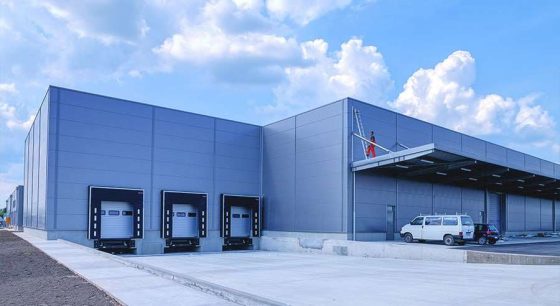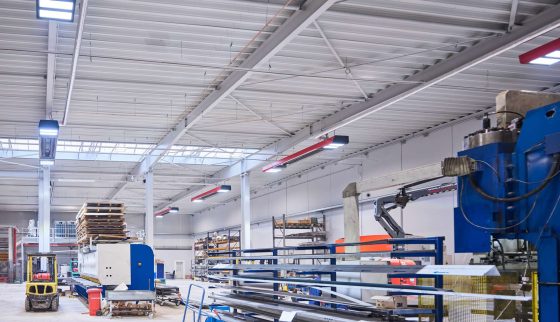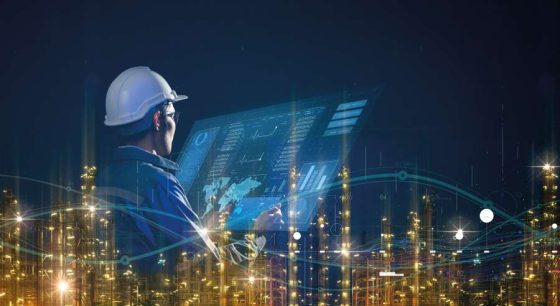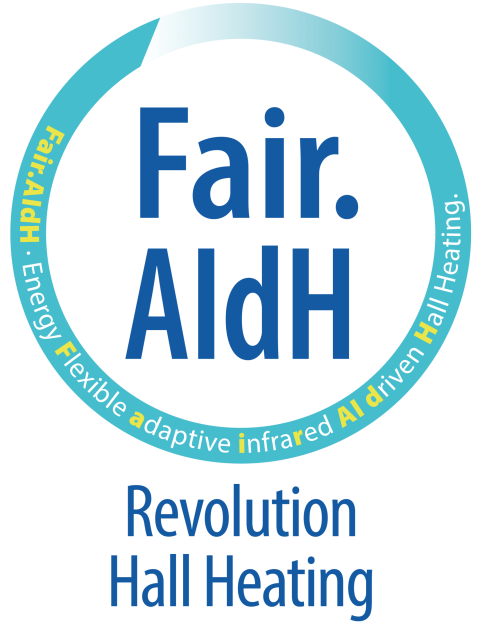How to find the ideal hall heating

First of all, realize that industrial and commercial buildings have different heating requirements than homes or offices. Sounds trivial? But it's not. In fact, many planners still make the mistake of using a similar heating strategy to that used for multi-storey buildings. The problem: warm air rises upwards. With low ceiling heights, such as in offices or apartments, this is not relevant. In halls, on the other hand, the warm air collects virtually uselessly at great heights under the hall roof.
Until it is pleasantly warm on the floor, operators have to channel a lot of heating energy into the hall and use systems that direct air flows back down again. This is basically a waste of money, as heat in large halls is usually only required at a person height of around two meters, but not at higher levels. It is therefore usually sufficient to heat 20 percent of the room volume. Even then, employees are pleasantly warm and can develop their full productivity.
Find the right technology for your hall heating
Now the question arises as to which technology should be used to optimize the approximately 20 percent of your Targeted heating of the hall. If you look around the market, you'll notice: There are centralized and decentralized Heating systems. Central systems include industrial underfloor heating systems, centrally supplied, water-based air heaters and hot water radiant ceiling panels. They work with a central energy generator and a pipe system that transports hot water to the desired location.
Zu den dezentralen Heizsystemen hingegen zählen Infrarotstrahler, die sich unter der Decke montieren lassen. Sie werden energieflexibel* mit erneuerbaren Energien wie Strom bzw. Wasserstoff oder traditionell auch noch mit Gas betrieben und arbeiten mit elektromagnetischen Wellen. Sobald die Wellen auf einen Festkörper treffen, etwa auf einen Menschen oder die Raumfassung, wandelt sich die Energie in Wärme um. Der Clou: Infrarotstrahler erhitzen nicht die Luft! Somit wird gezielt ausschließlich der Aufenthalts- und Nutzungsbereich beheizt. Das spart große Mengen Energie und macht Infrarotstrahler sehr effizient.
At the same time, hall operators enjoy flexibility. They divide the hall into different heating zones using several infrared radiators - and provide employees in order picking, for example, with more heat than colleagues in production, where Machines already provide sufficient basic heat provide. Flexibility that increases employee satisfaction. These decentralized solutions also make it easier to adapt the system when the hall is converted compared to a centralized system.
Another advantage of the Infrared technologyIt is quick to react. Operators switch the heating on and off in a similar way to a light. As the energy does not take a detour via the air, heat is available virtually at the touch of a button. And in the age of automation, you don't even need to switch it on and off manually. This task is performed by intelligent control technology, which adapts the heating output to the changing conditions. Users thus reduce energy costs by up to 70 percent, so that the investment in the heating system pays for itself in a short time.
* Fair.AIdH*-Technologie. Die neue energieflexible Heizungstechnologie wurde für die wirtschaftliche Dekarbonisierung speziell von Hallengebäuden entwickelt und ist bereits vielfach ausgezeichnet. Die Abkürzung bedeutet: Energy Flexible, adaptive, infrared, AI driven Hall Heating.
Get an overview of the requirements of your hall
In order for hall heating systems to develop their full potential, they should be adapted to your hall like a tailor-made suit. However, this adaptation by an external service provider will only be successful if you have a clear picture of your hall building, the hall usage and your requirements for the heating in advance. Pay particular attention to the factors that could influence the temperature. These questions can help you:
- What are the dimensions of your hall?
- What is the condition of the building?
- How is the hall used?
- Are there different areas and times of use?
- What about the gate opening times?
- How has heating been used so far - is there any consumption data?
- What goals and requirements should the new heating system meet?
- Welche Dekarbonisierungsstrategie verfolgen Sie?
The answers to these questions form a foundation on which your heating partner can build.
Think through different energy sources for your hall heating system
In times of climate change, the German government's targets are ambitious: Germany is to be climate-neutral by 2045 at the latest. The economy is making corresponding efforts, CO₂-Emissionen zu senken. Viele Unternehmen verabschieden sich von fossilen Energieträgern und setzen stattdessen auf regenerative Energien und Technologien wie Solarthermie oder elektrische Wärmepumpen.
If you decide to go down this route, however, you should be aware that you are committing to a central heating system. And for this you need a hydraulic distribution system. In addition, such a system is often associated with two to four times higher investment costs and is comparatively slow to react, meaning that in many cases the heat supply cannot be adapted quickly enough to dynamic requirements.
Infrarotstrahler arbeiten energieflexibel mit erneuerbaren Energien wie Strom oder Wasserstoff, oder – solange diese noch nicht ausreichend verfügbar sind – auch mit Erdgas. Hierzu eine wichtige Information: Abgesehen davon, dass Gas nach wie vor als Brückentechnologie und für die Betriebssicherheit notwendig ist und verglichen mit anderen fossilen Energieträgern als der CO₂-ärmste unter den klassischen Brennstoffen gilt, da es von allen den niedrigsten Primärenergiefaktor aufweist, wird Gas durch die kommende Zuspeisung von regenerativ erzeugtem Wasserstoff (Power-to-Gas-Technologie) zunehmend grün und gilt gerade in Verbindung mit dem hervorragend ausgebauten Gasnetz in Deutschland als einer der auch zukünftig wichtigen Energieträger.
Jetzt fragen Sie sich vielleicht: Das Gebäude-Energie-Gesetz (GEG) schreibt seit 2024 doch vor, dass ich zukünftig nur noch mit regenerativen Energien heizen darf. Ist da ein Infrarotstrahler nicht verboten? Nein! Ab einer Hallenhöhe von über vier Metern sind Sie laut GEG nicht mehr an regenerative Energiequellen gebunden, wenn Sie Ihre alten Bestandshallen energetisch sanieren wollen. Während zentrale Heizungssysteme zur Nutzung erneuerbarer Energie verpflichtet sind, um die GEG-Vorgaben zu erfüllen, lassen sich diese mit effizientester Infrarot-Hallenheizungstechnik auch mit Erdgas umsetzen. Sie müssen sich somit um die Compliance keine Sorgen machen.
Take a close look at suppliers of hall heating systems
To ensure that you find an efficient and future-proof hall heating system, you should check the competence of providers in advance. The following questions can be used as a guide:
- What references does the provider have?
- Is there a nationwide service (if you have or would like to set up several locations)?
- Can you be sure that you will still receive spare parts and service in 15 years' time?
- Does the provider have a development department that is innovative and develops products according to modern standards?
- Do the employees appear competent?
- Is the system flexible? Can it be easily adapted to changes in legislation and conversions?
It is also advisable to focus not only on the price of the hall heating system, but also on the total cost of ownership (TCO) - i.e. the operating costs over the entire life cycle. Only with this value can you calculate whether it is a worthwhile investment.
-
Not only politicians have pulled the ripcord, many companies are also planning to extend the Christmas break and shut down operations at least until the second week of January. Machines will be at a standstill for weeks and the doors to the factory buildings will remain closed.
-
According to the IMD Competiveness Ranking 2024[1], our once leading industrial nation has slipped from 6th to 24th place in just ten years. 45 percent of industrial companies with high electricity costs are planning or implementing plans to reduce their production or relocate it abroad. And the trend is rising[2]. Increasing bureaucratic costs and the extremely high level of energy prices in our country are causing many companies to [...]
-
Whether concert fans, art lovers or party enthusiasts: the room temperature also determines the success of events. How hosts ensure a comfortable climate in event halls and exhibition rooms with hall heaters.
-
What is probably the most effective lever against the gas crisis, price pressure and dependence on Russia at the moment? The answer: consuming less energy. The German government is of this opinion and is calling for energy savings in a large-scale campaign - supported by industry and associations. This goal can be achieved. When it comes to the large halls of industrial and commercial enterprises, it is even easier and quicker than expected.





